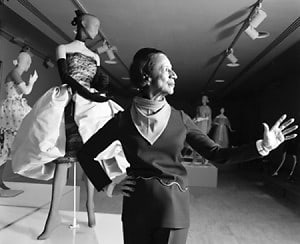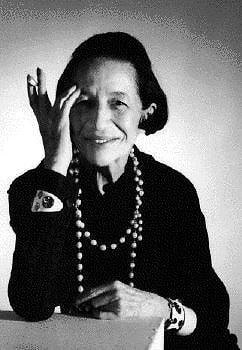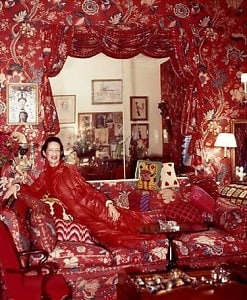 Her singular style in the cookie-cutter '50s catapulted this housewife from Harper's Bazaar columnist to legendary Vogue editor-in-chief, and now we're taking a look back at some of Diana Vreeland's greatest hits, biggest misses, and wildest suggestions for injecting a little glam into every woman's life.-
Her singular style in the cookie-cutter '50s catapulted this housewife from Harper's Bazaar columnist to legendary Vogue editor-in-chief, and now we're taking a look back at some of Diana Vreeland's greatest hits, biggest misses, and wildest suggestions for injecting a little glam into every woman's life.-
-
-
-
-
-
 Diana Vreeland never believed she was beautiful, but she more than made up for her perceived physical shortcomings with a brilliant eye for the chic, the unique, and the avant-garde. Beginning in 1937 her column "Why Don't You?" catapulted her from magazine paeon to arbitor of the wacky and wonderful, all in the name of living stylishly. Among her featured suggestions are the memorable, "Why don't you turn your child into an Infanta for a fancy-dress party?" and "Why don't you own, as does one extremely smart woman, twelve diamond roses of all sizes?" For a readership still reeling from Depression and, later, ensconced in war, the column was outlandish and unrealistic but also established a personal credo: "Don't just be your ordinary dull self. Why don't you be ingenious and make yourself into something else?"
Diana Vreeland never believed she was beautiful, but she more than made up for her perceived physical shortcomings with a brilliant eye for the chic, the unique, and the avant-garde. Beginning in 1937 her column "Why Don't You?" catapulted her from magazine paeon to arbitor of the wacky and wonderful, all in the name of living stylishly. Among her featured suggestions are the memorable, "Why don't you turn your child into an Infanta for a fancy-dress party?" and "Why don't you own, as does one extremely smart woman, twelve diamond roses of all sizes?" For a readership still reeling from Depression and, later, ensconced in war, the column was outlandish and unrealistic but also established a personal credo: "Don't just be your ordinary dull self. Why don't you be ingenious and make yourself into something else?"
After all, that's what she did.
-
-
 Vreeland transformed herself from ugly duckling daughter of a society swan into an international force of cool simply by wearing Chanel and walking into the St. Regis Hotel. Bazaar editor-in-chief Carmel Snow spotted the chic mother of two and was instantly inspired. A star was born.
Vreeland transformed herself from ugly duckling daughter of a society swan into an international force of cool simply by wearing Chanel and walking into the St. Regis Hotel. Bazaar editor-in-chief Carmel Snow spotted the chic mother of two and was instantly inspired. A star was born.
In that halcyon pre-internet heyday of the women's magazine, Vreeland became a major player on New York City's "scene", instantly recognized by her jet black bob, aquiline nose, and tendency to speak in epigrams. A move to Vogue in 1963 cemented her status as fashion's most respected , hired by Sam Newhouse as a gift to his wife who wanted the best editor-in-chief money could hire. Though it was at Bazaar that she earned fame for her cheeky aesthetic, it was at Vogue that she became an icon.
She broke new ground in the fashion world by featuring and celebrating American designers in her magazine, decorated her entire apartment in red to resemble "a garden in hell" [via NYMag], and reveled in the Youthquake of the 'Sixties, a time of great individual expression, art, and bright young things. But no one was brighter than she, lording over Manhattan's fashion elites like Anna Wintour does today. Said former accessories editor Nuala Boylan,
 "A limousine would arrive, in the late morning or at lunchtime, and the door would snap open, and she would step out dressed in her usual head-to-foot black -- cashmere sweater, black wrap skirt, the pointed shoes, now famous, that were polished on the bottoms. The hands were beautifully manicured, the hair just so. It was a helmet -- once when her maid bumped into it by mistake with a tray, it clinked. And waiting at the curb, there would always be one assistant. . . . We would hear the clicking of feet and her loud voice over her shoulder dictating memos at a mile a minute." [via NYMag]
"A limousine would arrive, in the late morning or at lunchtime, and the door would snap open, and she would step out dressed in her usual head-to-foot black -- cashmere sweater, black wrap skirt, the pointed shoes, now famous, that were polished on the bottoms. The hands were beautifully manicured, the hair just so. It was a helmet -- once when her maid bumped into it by mistake with a tray, it clinked. And waiting at the curb, there would always be one assistant. . . . We would hear the clicking of feet and her loud voice over her shoulder dictating memos at a mile a minute." [via NYMag]
Vreeland's seeming disregard for the "average" at all costs often cost her the respect of readers who claimed she was out of touch with what real women want. In fact this disconnect caused her firing from Vogue in 1971. But time has proven that her rules for living chicly, her outlandish advice, and her gambles on those not-yet-starlets, from Lauren Bacall to Ali McGraw, were not made in vain. Chances are if you care at all about fashion in 2010 you have lifted inspiration from Vreeland, who first pushed American women to ask themselves, "Why don't I?
Guest of a Guest would like to resuscitate Ms. Vreeland's column in a daily feature, "Why Don't You...". While we don't expect to fill her shoes, we certainly hope that our attempt to bring Why Don't You into the 21st century would make her proud. [Why Don't You]


.jpg)
.jpg)



.jpg)
.jpg)
.jpg)




